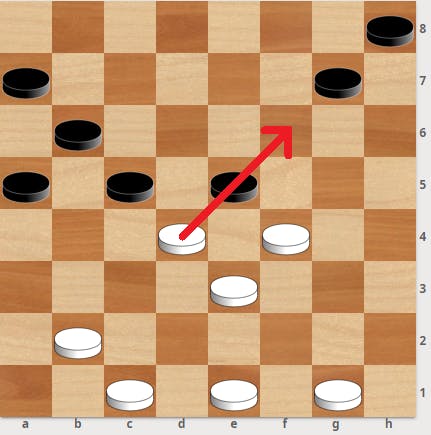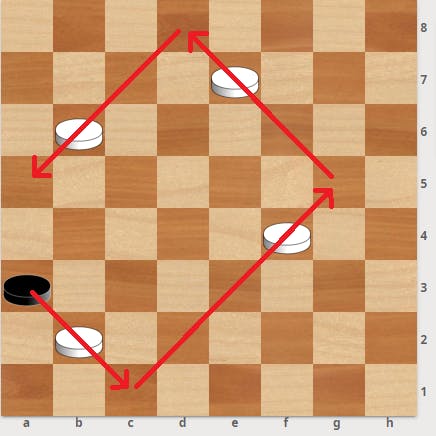Russian
Choice of capture, promotion during a multi-capture
Moves and captures
The rules for moving the pieces are the same as International draughts, with two major exceptions: choice of capture and promotion during a multi-capture.
- In Russian draughts a player is forced to capture when there is a capture possible. A player may choose any capture that is available, and is not forced to play the longest sequence. However, once a capture chain has started, a player must always finish the whole capture. In the diagram below, white can choose to capture d4:f6 or f4:b4. White is not allowed to capture only f4:d6, because the whole capture sequence has to be finished.

- If a man touches the opponent's back row during a multi-capture, the man promotes immediately and can continue to capture as a king. If no further capture is possible with the king, the turn ends after the promotion. In the diagram below, black does not simply promote with a3:c1, but wins immediately by capturing all enemy pieces with a3:a5 (a3:c1:g5:d8:a5).

Winning and drawing
The rules for winning and drawing are the same for Russian, Brazilian and Pool draughts:
- A player wins the game when the opponent no longer has any valid moves. This can be either because all of the player's pieces have been captured, or because they are all blocked and thus have no more squares available to move to.
- If the same position appears on the board for the third time, with the same side to move, the game is considered drawn by threefold repetition.
- If a player has three kings (or more) against one single enemy king (no men left on the board), the game is drawn after 15 moves. In other words: if the player with three kings or more does not win within 16 moves, the game is considered a draw.
- If both players play 15 kingmoves (any king) without captures or moving men, the game is drawn.
- If both players have at least one king, and the balance of the pieces remains the same, the game is drawn after:
- both players play 30 moves in a 4- or 5-piece ending
- both players play 60 moves in a 6- or 7-piece ending - If a player has three kings, two kings and a man, or one king and two men, against one enemy king that is located on the long diagonal (a1-h8) and is the only piece on the long diagonal, the game is drawn after both players have made 5 moves.
- If a player has two kings, one king and a man or one king, against one enemy king, the game is drawn after both players have made 5 moves.